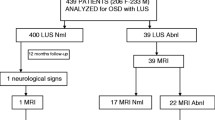Abstract
Objects
This study was conducted to investigate the frequency and type of cutaneous stigmata in different forms of occult spinal dysraphism (OSD) and their correlation to the underlying malformation.
Methods
Fourteen different forms of spinal malformations were identified in 358 operated patients with OSD. Most frequent findings (isolated or in combinations) were spinal lipoma, split cord malformation, pathologic filum terminale, dermal sinus, meningocele manqué, myelocystocele and caudal regression. Stigmata were present in 86.3% of patients, often in various combinations. Using a binary logistic regression analysis, significant correlations with distinct malformations were found for subcutaneous lipomas, skin tags, vascular nevi, pori, hairy patches, hypertrichosis, meningoceles and “cigarette burn” marks.
Conclusions
Cutaneous markers in a high percentage accompany spinal malformations. Due to the correlations of different stigmata to distinct malformations, they can aid the clinician in further diagnostic and therapeutic work.








Similar content being viewed by others
References
Albright AL, Gartner JC, Wiener ES (1989) Lumbar cutaneous hemangiomas as indicators of tethered spinal cords. Pediatrics 83:977–980
Anderson FM (1975) Occult spinal dysraphism: a series of 73 cases. Pediatrics 55:826–835
Ben-Amitai D, Davidson S, Schwartz M, Prais D, Shamir R, Metzker A, Merlob P (2000) Sacral nevus flammeus simplex: the role of imaging. Pediatr Dermatol 17:469–471
Boyvat A, Yazar T, Ekmekci P, Gurgey E (2000) Lumbosacral vascular malformation: a hallmark for occult spinal dysraphism. Dermatology 201:374–376
Drolet BA (2000) Cutaneous signs of neural tube dysraphism. Pediatr Clin North Am 47:813–823
Gibson PJ, Britton J, Hall DM, Hill CR (1995) Lumbosacral skin markers and identification of occult spinal dysraphism in neonates. Acta Paediatr 84:208–209
Hall DE, Udvarhelyi GB, Altman J (1981) Lumbosacral skin lesions as markers of occult spinal dysraphism. JAMA 246:2606–2608
Higginbottom MC, Jones KL, James HE, Bruce DA, Schut L (1980) Aplasia cutis congenita: a cutaneous marker of occult spinal dysraphism. J Pediatr 96:687–689
Humphreys RP (1996) Clinical evaluation of cutaneous lesions of the back: spinal signatures that do not go away. Clin Neurosurg 43:175–187
Jacobs AH, Walton RG (1976) The incidence of birthmarks in the neonate. Pediatrics 58:218–222
Kriss VM, Desai NS (1998) Occult spinal dysraphism in neonates: assessment of high-risk cutaneous stigmata on sonography. Am J Roentgenol 171:1687–1192
Kumar R, Bansal KK, Chhabra DK (2001) Split cord malformation (scm) in paediatric patients: outcome of 19 cases. Neurol India 49:128–133
McLone DG, La Marca F (1997) The tethered spinal cord: diagnosis, significance, and management. Semin Pediatr Neurol 4:192–208
Pang D (1992) Split cord malformation. Part II: Clinical syndrome. Neurosurgery 31:481–500
Pierre-Kahn A, Zerah M, Renier D, Cinalli G, Sainte-Rose C, Lellouch-Tubiana A, Brunelle F, Le Merrer M, Giudicelli Y, Pichon J, Kleinknecht B, Nataf F (1997) Congenital lumbosacral lipomas. Childs Nerv Syst 13:298–334
Powell KR, Cherry JD, Hougen TJ, Blinderman EE, Dunn MC (1975) A prospective search for congenital dermal abnormalities of the craniospinal axis. J Pediatr 87:744–750
Scatliff JH, Kendall BE, Kingsley DP, Britton J, Grant DN, Hayward RD (1989) Closed spinal dysraphism: analysis of clinical, radiological, and surgical findings in 104 consecutive patients. Am J Roentgenol 152:1049–1057
Soonawala N, Overweg-Plandsoen WC, Brouwer OF (1999) Early clinical signs and symptoms in occult spinal dysraphism: a retrospective case study of 47 patients. Clin Neurol Neurosurg 101:11–14
Tavafoghi V, Ghandchi A, Hambrick GWJ, Udverhelyi GB (1978) Cutaneous signs of spinal dysraphism. Report of a patient with a tail-like lipoma and review of 200 cases in the literature. Arch Dermatol 114:573–577
Weprin BE, Oakes WJ (2000) Coccygeal pits. Pediatrics 105:E69
Author information
Authors and Affiliations
Corresponding author
Rights and permissions
About this article
Cite this article
Schropp, C., Sörensen, N., Collmann, H. et al. Cutaneous lesions in occult spinal dysraphism—correlation with intraspinal findings. Childs Nerv Syst 22, 125–131 (2006). https://doi.org/10.1007/s00381-005-1150-4
Received:
Published:
Issue Date:
DOI: https://doi.org/10.1007/s00381-005-1150-4




